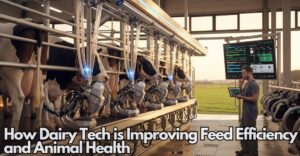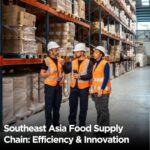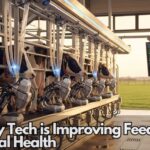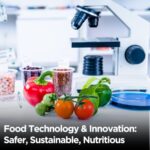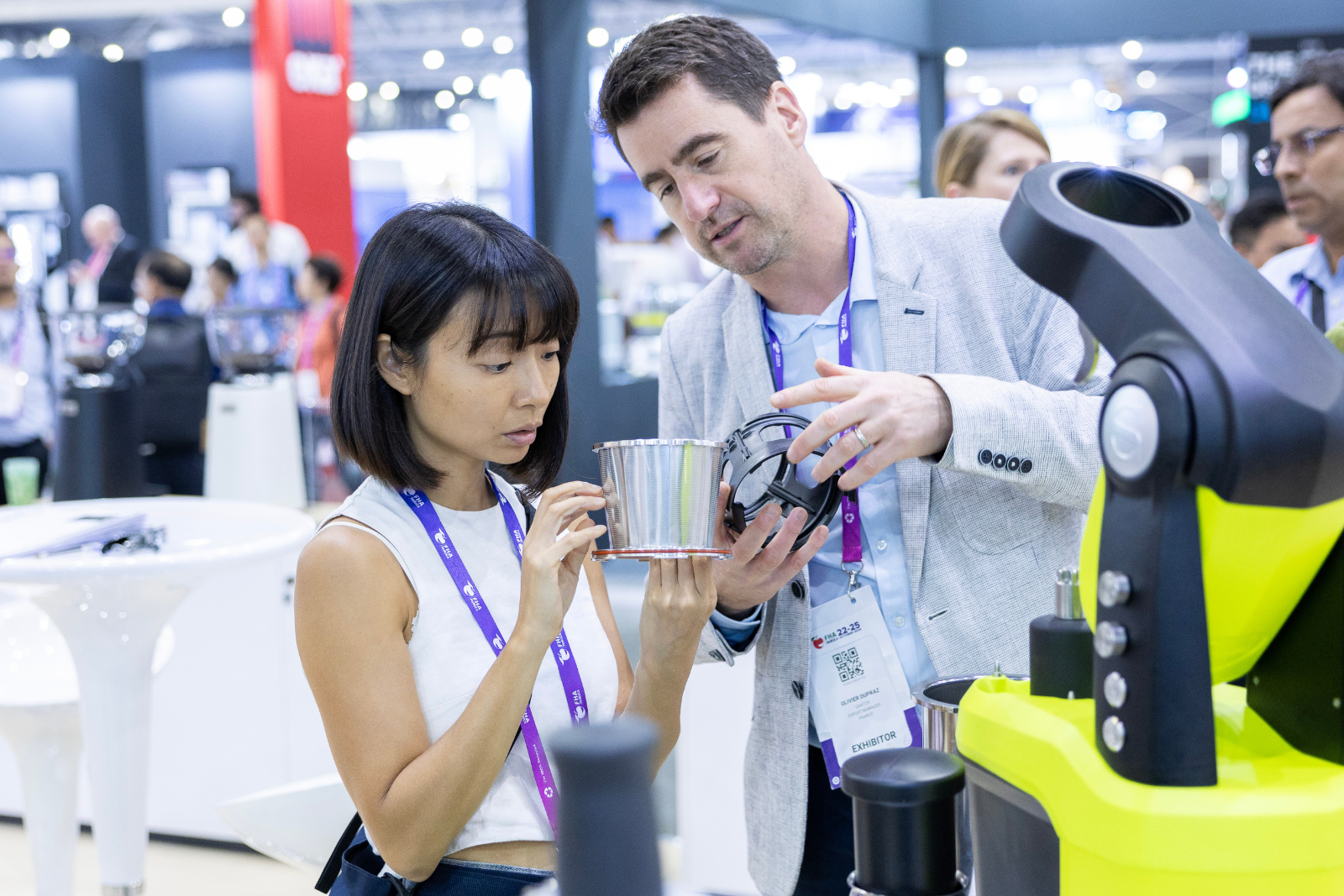When people think about innovation in the food industry, the focus often stays in the kitchen. However, many significant improvements are underway behind the scenes in factories, processing plants, and supply chains.
Predictive technology in food manufacturing is enabling producers to make informed decisions at every stage, from sourcing ingredients to final packaging.
By using real-time information, these systems help teams respond more quickly, minimize delays, and maintain smoother operations.
They support consistent product quality, help reduce waste, and make it easier to achieve both efficiency and sustainability goals. Being able to detect issues early means time, materials, and energy are used more wisely.
The use of intelligent systems in manufacturing is set to rise sharply. The market is projected to grow from $3.2 billion in 2023 to $20.8 billion by 2028.
This shows how food producers are adopting new methods to enhance operations, lower costs, and keep up with changing demands in a fast-moving industry.
What is Predictive Technology in Food Manufacturing?
Predictive technology in food manufacturing uses real-time data and learning models to enable producers to optimize their production management.
By recognizing patterns and identifying early signs of disruption, these systems allow teams to take action before problems arise. This results in better product consistency, fewer delays, and more efficient resource utilization.
A primary benefit is the ability to monitor equipment performance throughout the day. Instead of reacting to sudden breakdowns, teams receive alerts when machines show signs of wear or operate outside normal conditions.
This keeps operations on schedule and lowers the risk of costly repairs. Manufacturers using predictive maintenance systems have reported a 30-50% decrease in machine downtime, along with a 10-40% reduction in maintenance costs.
These systems also help manage the food supply chain by forecasting demand and adjusting inventory levels accordingly. This means fewer shortages or excess stock and better coordination across sourcing, storage, and delivery.
For food safety and quality management, predictive technology tracks processing data, such as temperature and timing, to identify and address any potential risks early.
With predictive analytics in F&B, manufacturers gain a clearer view of what’s happening across production. This supports faster, smarter decisions and helps teams avoid setbacks.
As automation in food manufacturing becomes more common, predictive systems are helping companies meet high standards while keeping costs under control.
Key Benefits of AI-Powered Predictive Tech in Food Manufacturing
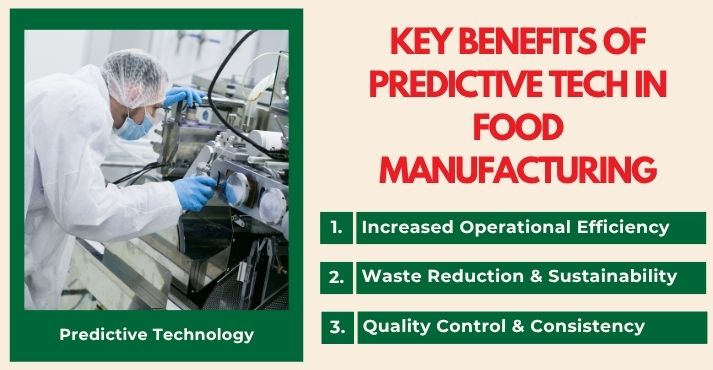
Predictive systems are becoming a valuable part of modern food manufacturing. These technologies help producers manage resources more effectively, enhance planning, and mitigate costly disruptions.
By turning raw data into useful insights, predictive methods support faster decisions and smoother operations across the board. Here are three areas where these systems provide strong benefits:
1. Increased Operational Efficiency
One of the most direct benefits of using predictive systems is improved efficiency across production lines.
By monitoring equipment conditions in real time, manufacturers can plan maintenance rather than respond to unexpected failures. This reduces downtime and keeps production schedules on track.
Production managers also benefit from better planning. With accurate insights into output patterns and performance, schedules can be adjusted to meet demand without overloading machines or staff.
This helps avoid bottlenecks, makes better use of energy and labor, and supports more reliable delivery timelines. In short, predictive methods improve how food manufacturing technology supports daily operations.
2. Waste Reduction and Sustainability
Forecasting demand more accurately leads to better control over raw material usage. When producers know how much of an item is needed and when, they can order ingredients in the right quantities.
This reduces food waste, lowers storage costs, and prevents spoilage. It also makes inventory management easier, especially during periods of high or unexpected demand.
Packaging is another area where predictive systems support smarter planning. By understanding what is needed and how much will be shipped, companies can reduce the overuse of packaging supplies and move toward more sustainable packaging options.
This helps meet environmental goals while reducing material costs, aligning with wider efforts to create more responsible production environments.
3. Quality Control and Consistency
Predictive systems also support better control over product quality. By keeping track of temperature, pressure, timing, and other production factors, they help ensure every batch meets the same standards.
Any sign of irregularity can be flagged early, allowing teams to make corrections before larger issues arise.
This level of consistency is crucial in large-scale operations, where even slight variations can impact shelf life, taste, or safety.
With smart manufacturing systems in place, producers can manage quality more precisely without slowing down the line. This leads to better customer satisfaction and stronger compliance with food safety guidelines.
The role of AI in food production continues to expand, not only by automating tasks but also by enhancing the decision-making process. As more companies adopt predictive systems, the focus remains on creating reliable, cost-effective, and high-quality food at scale.
AI Applications in Food Manufacturing
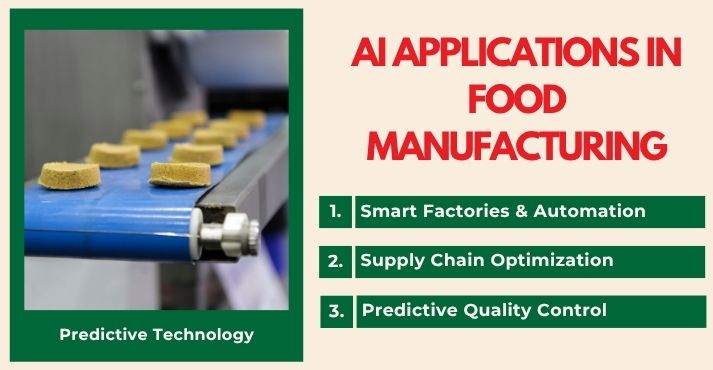
New technologies are enhancing the operations of food manufacturers, from production floors to the global supply chain. These systems are no longer limited to high-tech labs, but are actively supporting the day-to-day functions of many facilities.
Here’s how they’re being used across major areas:
1. Smart Factories and Automation
Smart factories in F&B are leading the way in modernizing production. In these facilities, connected equipment tracks operations and reports performance data in real-time.
This supports better decisions on the line, allowing teams to make quick adjustments without waiting for problems to surface.
Robotic arms and automated packing stations also improve output speed and precision. These machines handle repetitive tasks efficiently, freeing up workers for more complex responsibilities.
Monitoring systems establish continuous feedback loops that fine-tune processes as operations unfold, enabling consistent performance to be maintained.
Today, 72% of manufacturers worldwide are running smart factory initiatives. These initiatives support the adoption of more responsive and data-informed production systems in the food sector.
2. Supply Chain Optimization
Modern manufacturing depends on strong coordination across sourcing, storage, and delivery. With better forecasting, producers can prepare for changes in demand and adjust inventory accordingly. This reduces spoilage, lowers storage costs, and keeps shelves stocked with the right products.
A well-organized system also supports more predictable timelines with suppliers. Predictive technology identifies possible slowdowns and allows adjustments before issues escalate. This strengthens supplier relationships and helps build a more resilient food supply chain.
43% of companies plan to adopt demand forecasting systems that rely on these technologies within the next two years.
This level of planning shows the industry’s commitment to developing smarter, AI-powered supply chains that maintain operational efficiency even in uncertain times.
3. Predictive Quality Control
Food manufacturers are responsible for delivering safe, consistent products at scale. Predictive systems help by continuously testing quality during production.
Rather than checking items after they’re made, sensors and monitors detect small changes in the process that could lead to problems.
This real-time insight allows adjustments while production is still underway. Temperature, pH, pressure, and timing can be corrected on the spot, reducing waste and improving reliability.
It’s one of the ways food sustainability technology supports long-term goals — by reducing faulty batches and minimizing resource use.
These methods allow manufacturers to deliver high-quality products with fewer disruptions and improved efficiency, while maintaining stringent safety and compliance standards.
Case Studies: How Predictive Technology Is Already Making an Impact
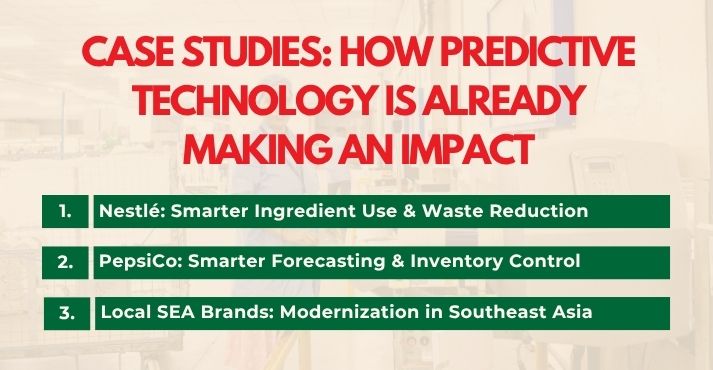
Here are real-world examples of food manufacturers using predictive systems to achieve real results in production, sourcing, and supply chain reliability.
1. Nestlé: Smarter Ingredient Use and Waste Reduction
Nestlé recently completed a trial using real-time monitoring to reduce edible food waste at one of its factories. Over just two weeks, the pilot project reduced surplus by 87%, translating to nearly 1.5 million meals reclaimed and preventing around 1,400 tonnes of CO₂ emissions.
This initiative saved millions in operating costs and provided insights into ingredient loss before products even leave the line.
Nestlé plans to roll out this method across more sites and through subscription access by early next year, helping standardize resource efficiency across the food supply chain.
2. PepsiCo: Smarter Forecasting and Inventory Control
PepsiCo strengthened its global operations by sharing retail purchase data alongside internal supply chain metrics. This combined information alerts supply teams when stock levels are declining and prompts retailers to reorder before shelves run out of stock.
At the same time, marketing spend is automatically adjusted when inventory levels are low, helping to prevent stockouts without wasting promotional budgets.
These predictive forecasting systems have helped PepsiCo reduce out-of-stock incidents, improve retailer relationships, and optimize inventory across its distribution network.
3. Local SEA Brands: Modernization in Southeast Asia
- Tee Yih Jia (Singapore and Malaysia) pioneered fully automated spring roll pastry production in 1984, setting a benchmark for efficiency in ready-to-eat manufacturing. The company continues to expand automation across its production lines in Singapore (Senoko) and Johor, Malaysia. Both facilities incorporate real-time line monitoring and regular quality audits to ensure consistent product standards across regional operations.
- Thai Union (Thailand), a global leader in seafood, has introduced advanced traceability measures to ensure transparency and safety in shrimp production. Since late 2021, they have partnered with Sea Warden and Wholechain to use satellite imaging and blockchain-backed data tracking. This system collects information on shrimp farms and links it directly to each shrimp’s journey from harvest to packaging. The result is a clear, verifiable overview of sourcing practices and quality control.
The Road Ahead: Challenges and Opportunities
While predictive technology has the potential to improve food production, its integration does not come without obstacles. One of the most immediate concerns for manufacturers is the high upfront investment required for system upgrades.
From sensors and infrastructure to custom software solutions, the cost of implementation can be significant, especially for small to mid-sized producers.
Another challenge is integrating new systems with existing operations. Many food manufacturers still rely on legacy equipment, making it difficult to standardize data inputs or achieve seamless communication between different parts of the production line.
This can limit the effectiveness of predictive models unless significant upgrades or modifications are made.
Data security is also a growing concern. As operations become increasingly connected, safeguarding proprietary information and sensitive operational data becomes critical. Without strong cybersecurity protocols, the risks of breaches or misuse increase.
On the regulatory side, food producers must ensure their data collection and processing methods comply with both local and international food safety standards. Navigating these rules requires dedicated compliance strategies and ongoing audits.
Workforce readiness is another significant barrier. Many teams are unfamiliar with the advanced analytics used in AI-powered manufacturing, and upskilling staff can be a time-intensive process.
Building internal capabilities takes time, and some manufacturers may need to rely on third-party experts in the short term.
Despite these hurdles, the long-term opportunities are substantial. As systems mature and become more accessible, even smaller producers can benefit from data-driven food production, optimizing output while reducing waste.
Manufacturers that invest early stand to gain a competitive edge, provided they plan for the technical, regulatory, and human challenges ahead.
How F&B Brands Can Prepare for the AI Revolution in Manufacturing
Getting started with predictive technology does not have to be complex or overwhelming. The most effective way for food and beverage companies to begin is by testing it in one specific area of their operation.
For example, starting with a single line to monitor machine conditions or forecast short-term demand can show quick results and help teams understand what’s working.
To support long-term success, building a culture that values data is essential. It means providing staff with access to the right information, helping them understand how it relates to their daily decisions, and offering regular training.
When teams are confident in using new systems, they can respond more quickly and identify small issues before they escalate.
Working with experienced partners can also make a difference. Companies that specialize in food production automation often bring practical knowledge of equipment, safety regulations, and production needs that align with your specific environment. Their support can shorten setup time and help avoid unnecessary costs.
With the rise of robotics in manufacturing, there is also an increasing need to connect machines with smarter decision-making.
Food producers who start preparing now by making small changes, investing in their teams, and finding the right partners will be better equipped to run more reliable and efficient operations in the future.
Conclusion
Predictive technology is becoming essential for food manufacturers that want to stay competitive and meet growing consumer expectations.
From monitoring production lines to anticipating demand and enhancing product consistency, these systems deliver tangible benefits.
Companies that invest in accurate forecasting, tighter quality control, and more efficient supply chain planning can reduce waste and manage costs more effectively.
Preparing for the future means finding smarter ways to manage food production. Predictive systems help businesses respond quickly to changes, avoid disruptions, and make confident decisions backed by accurate insights.
For manufacturers seeking to enhance their planning, production, and delivery processes, predictive technology enables more efficient operations and improved performance throughout the entire production cycle.




